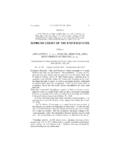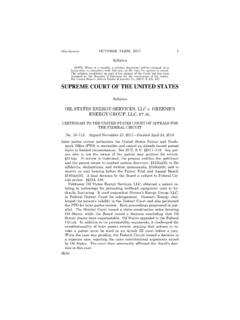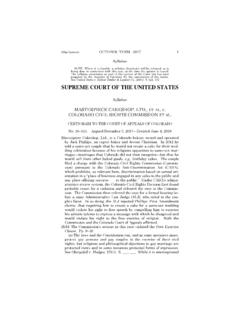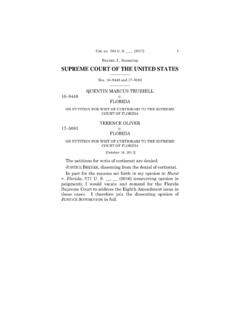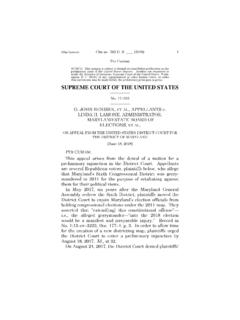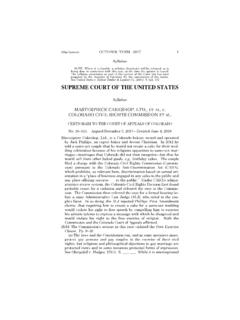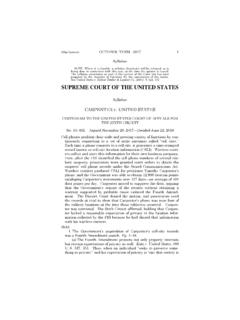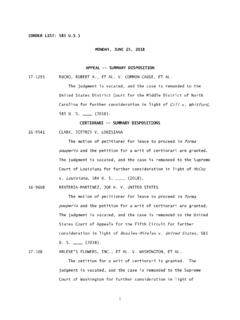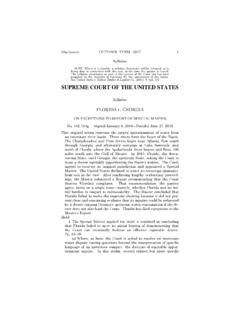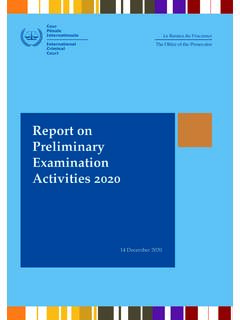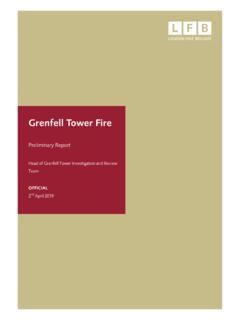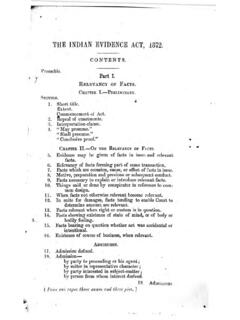Transcription of SUPREME COURT OF THE UNITED STATES
1 1 (Slip Opinion) OCTOBER TERM, 2020 Syllabus NOTE: Where it is feasible, a syllabus (headnote) will be released, as is being done in connection with this case, at the time the opinion is issued. The syllabus constitutes no part of the opinion of the COURT but has been prepared by the Reporter of Decisions for the convenience of the reader. See UNITED STATES v. Detroit Timber & Lumber Co., 200 U. S. 321, 337. SUPREME COURT OF THE UNITED STATES Syllabus CANIGLIA v. STROM ET AL. CERTIORARI TO THE UNITED STATES COURT OF APPEALS FOR THE FIRST CIRCUIT No. 20 157. Argued March 24, 2021 Decided May 17, 2021 During an argument with his wife, petitioner Edward Caniglia placed a handgun on the dining room table and asked his wife to shoot [him] and get it over with.
2 His wife instead left the home and spent the night at a hotel. The next morning, she was unable to reach her hus-band by phone, so she called the police to request a welfare check. The responding officers accompanied Caniglia s wife to the home, where they encountered Caniglia on the porch. The officers called an ambu-lance based on the belief that Caniglia posed a risk to himself or others. Caniglia agreed to go to the hospital for a psychiatric evaluation on thecondition that the officers not confiscate his firearms. But once Caniglia left, the officers located and seized his weapons. Canigliasued, claiming that the officers had entered his home and seized him and his firearms without a warrant in violation of the Fourth Amend-ment. The District COURT granted summary judgment to the officers.
3 The First Circuit affirmed, extrapolating from the COURT s decision in Cady v. Dombrowski, 413 U. S. 433, a theory that the officers removal of Caniglia and his firearms from his home was justified by a commu-nity caretaking exception to the warrant requirement. Held: Neither the holding nor logic of Cady justifies such warrantless searches and seizures in the home. Cady held that a warrantless search of an impounded vehicle for an unsecured firearm did not vio-late the Fourth Amendment. In reaching this conclusion, the COURT noted that the officers who patrol the public highways are often called to discharge noncriminal community caretaking functions, such as responding to disabled vehicles or investigating accidents. 413 U. S., at 441. But searches of vehicles and homes are constitutionallydifferent, as the Cady opinion repeatedly stressed.
4 Id., at 439, 440 442. The very core of the Fourth Amendment s guarantee is the right 2 CANIGLIA v. STROM Syllabus of a person to retreat into his or her home and there be free from un-reasonable governmental intrusion. Florida v. Jardines, 569 U. S. 1, 6. A recognition of the existence of community caretaking tasks, likerendering aid to motorists in disabled vehicles, is not an open-ended license to perform them anywhere. Pp. 3 4. 953 F. 3d 112, vacated and remanded. THOMAS, J., delivered the opinion for a unanimous COURT . ROBERTS, C. J., filed a concurring opinion, in which BREYER, J., joined. ALITO, J., and KAVANAUGH, J., filed concurring opinions. _____ _____ 1 Cite as: 593 U.
5 S. ____ (2021) Opinion of the COURT NOTICE: This opinion is subject to formal revision before publication in the preliminary print of the UNITED STATES Reports. Readers are requested to notify the Reporter of Decisions, SUPREME COURT of the UNITED STATES , Wash-ington, D. C. 20543, of any typographical or other formal errors, in order that corrections may be made before the preliminary print goes to press. SUPREME COURT OF THE UNITED STATES No. 20 157 EDWARD A. CANIGLIA, PETITIONER v. ROBERT F. STROM, ET AL. ON WRIT OF CERTIORARI TO THE UNITED STATES COURT OF APPEALS FOR THE FIRST CIRCUIT [May 17, 2021] JUSTICE THOMAS delivered the opinion of the COURT . Decades ago, this COURT held that a warrantless search of an impounded vehicle for an unsecured firearm did not vio-late the Fourth Amendment.
6 Cady v. Dombrowski, 413 U. S. 433 (1973). In reaching this conclusion, the COURT ob-served that police officers who patrol the public highways are often called to discharge noncriminal community care-taking functions, such as responding to disabled vehiclesor investigating accidents. Id., at 441. The question today is whether Cady s acknowledgment of these caretaking duties creates a standalone doctrine that justifies warrant-less searches and seizures in the home. It does not. I During an argument with his wife at their Rhode Islandhome, Edward Caniglia (petitioner) retrieved a handgun from the bedroom, put it on the dining room table, andasked his wife to shoot [him] now and get it over with. She declined, and instead left to spend the night at a hotel.
7 The next morning, when petitioner s wife discovered that shecould not reach him by telephone, she called the police (re-spondents) to request a welfare check. 2 CANIGLIA v. STROM Opinion of the COURT Respondents accompanied petitioner s wife to the home, where they encountered petitioner on the porch. Petitioner spoke with respondents and confirmed his wife s account of the argument, but denied that he was suicidal. Respond-ents, however, thought that petitioner posed a risk to him-self or others. They called an ambulance, and petitioneragreed to go to the hospital for a psychiatric evaluation but only after respondents allegedly promised not to confis-cate his firearms.
8 Once the ambulance had taken petitioner away, however, respondents seized the weapons. Guided by petitioner s wife whom they allegedly misinformed about his wishes respondents entered the home and tooktwo handguns. Petitioner sued, claiming that respondents violated theFourth Amendment when they entered his home and seized him and his firearms without a warrant. The District COURT granted summary judgment to respondents, and the First Circuit affirmed solely on the ground that the decision to remove petitioner and his firearms from the premises fell within a community caretaking exception to the warrantrequirement. 953 F. 3d 112, 121 123, 131 and nn. 5, 9 (2020). Citing this COURT s statement in Cady that policeofficers often have noncriminal reasons to interact with mo-torists on public highways, 413 U.
9 S., at 441, the First Cir-cuit extrapolated a freestanding community-caretaking ex-ception that applies to both cars and homes. 953 F. 3d, at 124 ( Threats to individual and community safety are notconfined to the highways ). Accordingly, the First Circuitsaw no need to consider whether anyone had consented to respondents actions; whether these actions were justifiedby exigent circumstances ; or whether any state law per-mitted this kind of mental-health intervention. Id., at 122 123. All that mattered was that respondents efforts to pro-tect petitioner and those around him were distinct from the normal work of criminal investigation , fell within the realm of reason, and generally tracked what the COURT 3 Cite as: 593 U.
10 S. ____ (2021) Opinion of the COURT viewed to be sound police procedure. Id., at 123 128, 132 133. We granted certiorari. 592 U. S. ___ (2020). II The Fourth Amendment protects [t]he right of the people to be secure in their persons, houses, papers, and effects,against unreasonable searches and seizures. The very core of this guarantee is the right of a man to retreat intohis own home and there be free from unreasonable govern-mental intrusion. Florida v. Jardines, 569 U. S. 1, 6 (2013).To be sure, the Fourth Amendment does not prohibit allunwelcome intrusions on private property, ibid. only unreasonable ones. We have thus recognized a few per-missible invasions of the home and its curtilage. Perhapsmost familiar, for example, are searches and seizures pur-suant to a valid warrant.
